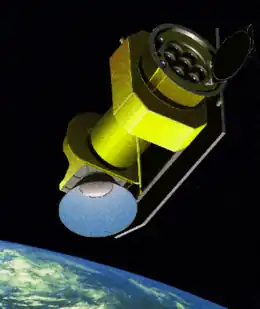 ABRIXAS in orbit. | |
| Mission type | X-ray astronomy |
|---|---|
| Operator | DLR |
| COSPAR ID | 1999-022A |
| SATCAT no. | 25721 |
| Mission duration | 0 years (mission failure) |
| Spacecraft properties | |
| Launch mass | 550.0 kilograms (1,212.5 lb) |
| Start of mission | |
| Launch date | 28 April 1999, 20:30 UTC |
| Rocket | Kosmos-3M |
| Launch site | Kapustin Yar 107 |
| End of mission | |
| Last contact | 1 May 1999 |
| Decay date | 31 October 2017[1] |
| Orbital parameters | |
| Reference system | Geocentric |
| Regime | Low Earth Orbit |
| Semi-major axis | 6,869.9 kilometers (4,268.8 mi) |
| Eccentricity | 0.00352 |
| Perigee altitude | 549 km (341 mi) |
| Apogee altitude | 598 km (372 mi) |
| Inclination | 48.0 degrees |
| Period | 96.00 minutes |
| Epoch | 28 April 1999, 04:30:00 UTC[2] |
A Broadband Imaging X-ray All-sky Survey, or ABRIXAS, was a space-based German X-ray telescope. It was launched on 28 April 1999 in a Kosmos-3M launch vehicle from Kapustin Yar, Russia, into Earth orbit. The orbit had a periapsis of 549.0 kilometres (341.1 mi), an apoapsis of 598.0 kilometres (371.6 mi), an inclination of 48.0° and an eccentricity of 0.00352, giving it a period of 96 minutes.[2][3]
The telescope's battery was accidentally overcharged and destroyed three days after the mission started. When attempts to communicate with the satellite — while its solar panels were illuminated by sunlight — failed, the $20 million project was abandoned.[4] ABRIXAS decayed from orbit on 31 October 2017.
The eROSITA telescope is based on the design of the ABRIXAS observatory.[5] eROSITA was launched on board the Spektr-RG space observatory on 13 July 2019 from Baikonur to be deployed at the second Lagrange point (L2).[6]
See also
References
- ↑ "ABRIXAS". Gunter's Space Page. Retrieved November 22, 2022.
- 1 2 "NASA – NSSD – Spacecraft – Trajectory Details (ABRIXAS)". NASA. Retrieved 2008-02-27.
- ↑ "NASA – NSSDC – Spacecraft – Details (ABRIXAS)". NASA. Retrieved 2008-02-27.
- ↑ "ABRIXAS". Astronautix.com. Archived from the original on December 28, 2016. Retrieved 2008-02-28.
- ↑ "Spectrum-RG/eRosita/Lobster mission definition document". Russian Space Research Institute. 2005-10-30. Retrieved 2011-02-04.
- ↑ Zak, Anatoly (16 April 2016). "Spektr-RG to expand horizons of X-ray astronomy". Russian Space Web. Retrieved 16 September 2016.